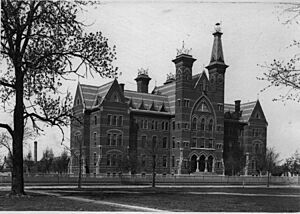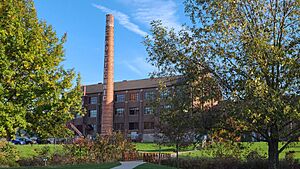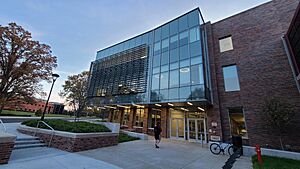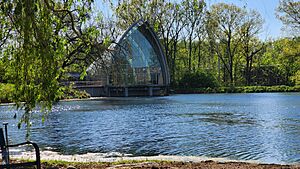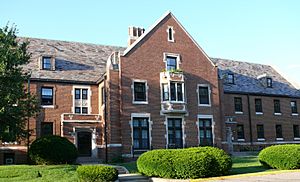Rose–Hulman Institute of Technology facts for kids
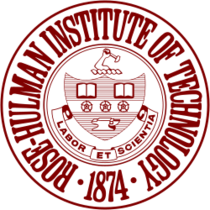 |
|
|
Former name
|
|
|---|---|
| Motto | Latin: Labor et scientia |
|
Motto in English
|
Work and Knowledge |
| Type | Private university |
| Established | 1874 |
| Accreditation | Higher Learning Commission |
|
Academic affiliations
|
|
| Endowment | $209.8 million (2020) |
| President | Robert A. Coons |
| Provost | Rick Stamper |
|
Academic staff
|
196 (fall 2022) |
| Undergraduates | 2,169 (fall 2022) |
| Postgraduates | 19 (fall 2022) |
| Location |
,
United States
|
| Campus | Suburban, 1,300 acres (530 ha) |
| Colors | Red and white |
| Nickname | Fightin' Engineers |
|
Sporting affiliations
|
NCAA Division III – HCAC |
| Mascot | Rosie the Elephant |
Rose–Hulman Institute of Technology (RHIT) is a special private university located in Terre Haute, Indiana, in the United States. It was started in 1874. This university offers many different programs in science, engineering, and technology. Students can earn bachelor's and master's degrees here.
Contents
History of Rose–Hulman
How it Started (1874–1917)
The school was founded by Chauncey Rose and nine friends in 1874. They called it the Terre Haute School of Industrial Science. Mr. Rose wanted to train local engineers because it was hard to find them for his railroad projects. He gave the land and most of the money to start the school.
A year later, the school's name was changed to Rose Polytechnic Institute. This happened even though Mr. Rose, who was the main supporter, didn't want the name changed. The first campus had only one building. There were no dorms or places for fun activities.
The first group of 48 students started in 1883. Most of them were from Indiana and all were male. Many chose to study mechanical engineering. Other choices were civil engineering and chemistry. The first president was Charles O. Thompson. He made the school like other engineering colleges in the eastern U.S. This made it the first private engineering college west of the Allegheny Mountains.
In 1889, the school gave out what it believed was the first chemical engineering degree in the country.
Moving and War Times (1917–1951)
In 1917, the school had grown to over 300 students. It moved to a new, larger location east of town. The Hulman family of Terre Haute donated this land. The new campus opened in 1922. It included an academic building, now called Moench Hall, and the first dorm, Deming Hall. Both are still used today.
Students at Rose had social groups and played sports. They also had fun pranks. For example, sophomores would invite freshmen to a baseball game. They would tell them to leave their pipes with the nurse. Then, at a certain time, the freshmen would show their pipes, and a playful fight would start!
During World War I, Rose Polytechnic trained students in technical skills. This included vehicle maintenance. They also started a Reserve Officers' Training Corps (ROTC) Engineer unit. This unit later became the Wabash Battalion Army ROTC program. During World War II, students could enter and graduate every three months. This helped support the war effort.
Growing Bigger (1960s–Present)
In 1971, the school's name changed to Rose–Hulman Institute of Technology. This was to honor the Hulman family for their big donations and support.
The school grew a lot in the 1960s and 1970s under President John A. Logan. Many new dorms, a student union, a library, and a recreation center were built. The school was allowed to have up to 1000 students.
From 1977 to 1995, a journal about secret codes called Cryptologia was published at Rose–Hulman.
For most of its history, Rose–Hulman was only for male students. In 1991, the school decided to allow women to attend. The first full-time women students started in 1995.
After 1995, Rose–Hulman grew even more thanks to a big fundraising effort. This campaign raised over $250 million by 2004. Many new buildings were added to the campus. These included the Olin Advanced Learning Center and The John T Myers Center for Technological Research. The Sports and Recreation Center was also built. The National Football League's Indianapolis Colts used it for their summer training from 1999 to 2010. In 2002, Hatfield Hall, a theater and alumni center, opened.
In 2018, the Hulman Memorial Student Union was updated. It was renamed the Mussallem Union after the main donors. This building is in the middle of campus. It has meeting spaces, dining areas, and health services for students.
In 2019, the Kremer Innovation Center (KIC) opened. It expanded the Branam Innovation Center (BIC). These centers help students create new things quickly. They have labs, classrooms, and workshops for student projects.
In 2021, a New Academic Building opened. It has labs for chemistry and food science. It also has study rooms and a large open area. This building is the first in Indiana to apply for WELL recognition, which means it's designed to support people's health and well-being.
Campus Life
Most of the university is inside the city of Terre Haute. Some parts are just outside the city limits. The campus is about 1300 acres, which is a very large area.
Academics and Learning
Rose–Hulman focuses on engineering and science. It mainly teaches students working towards their first college degree. There is also a small program for students earning a master's degree. The school does not offer doctoral programs.
As of 2021, Rose–Hulman has 189 teachers. Almost all of them (99%) have a PhD, which is a very high degree. There is one teacher for every 11 students. This means students get a lot of personal attention. It is hard to get into Rose–Hulman because many students want to go there.
School Quality and Rankings
Rose–Hulman has been ranked as the best engineering college in the U.S. that does not offer a doctorate degree. This ranking has been given by U.S. News & World Report for 24 years in a row! Each engineering program at the school, like Chemical, Civil, Computer, Electrical, Mechanical, and Biomedical Engineering, has also been ranked first.
The school is also ranked high for how much money students can earn after they graduate. This is called "Return on Investment."
Student Activities
Most students at Rose–Hulman come from the Midwestern United States. However, more students from other parts of the country and different backgrounds are joining the school. About 39% of students are from Indiana. Many also come from nearby states like Illinois, Ohio, Michigan, and Minnesota.
The school has many competition teams. These teams work on cool projects like:
- Team Rose Motorsports
- Grand Prix Engineering (building race cars)
- Human Powered Vehicle Challenge (designing vehicles powered by people)
- Rose Rocketry (building rockets)
- AIAA Design/Build/Fly (designing and building airplanes)
- Chem-E-Car (building cars powered by chemical reactions)
- MakerLab and Make It Happen (places for students to create things)
- Various robotics competitions
There are eight social fraternities (for men) and three social sororities (for women). Some of these groups have houses on campus. In 2003, almost 69% of students were part of these social groups.
Rose–Hulman Ventures helps students find internships and jobs. It works with new companies and big companies. This program started in 1999 with a large gift of $30 million.
Student Media
The school's student-run newspaper is called The Rose Thorn.
Rose–Hulman also has an amateur radio club, the Rose Tech Radio Club. They have a special radio station on campus.
The Rose–Hulman Film Club makes short films directed by students.
The campus radio station used to be WMHD-FM 90.7 FM, known as "The Monkey". It was run by student volunteers. In 2014, the station was sold to Indiana State University.
Sports Teams
The school's sports teams are called the Rose–Hulman Fightin' Engineers.
Famous Alumni
Many successful people have graduated from Rose–Hulman. Here are a few:
- Tim Cindric (1990): President of Penske Racing, a famous racing team.
- Ernest R. Davidson (1958): A scientist who won the National Medal of Science.
- Marshall Goldsmith (1970): A well-known expert in helping businesses and leaders.
- Don Lincoln (1986): A physicist who studies tiny particles.
- Art Nehf (1914): A professional baseball pitcher in Major League Baseball.
- Abe Silverstein (1929): An engineer who worked for NASA and won the Guggenheim Medal.
- Mike Thomas (2000): Co-founder of Monomi Park, a company that makes video games like Slime Rancher.
- Jim Umpleby (1980): Former CEO of Caterpillar, Inc., a big company that makes machinery.
- Bernard Vonderschmitt (1944): Co-founder of Xilinx, a company that makes computer chips.
- Robert L. Wilkins (1986): A judge in the United States.
See also
 In Spanish: Instituto de Tecnología Rose-Hulman para niños
In Spanish: Instituto de Tecnología Rose-Hulman para niños
- Association of Independent Technological Universities


